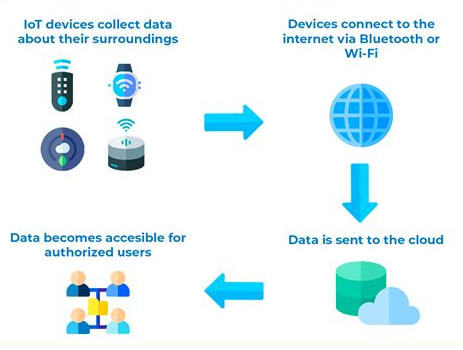
The Internet of Things (IoT) is a network of physical devices connected to the internet, able to collect and exchange data. Its uses are vast and extend into nearly every industry, from manufacturing to finance. However, one of its most transformative applications is in the healthcare sector, where IoT devices are being used to improve patient care, increase efficiency, and reduce costs.
How IoT Sensors Monitor Patient Health
IoT sensors can be used to monitor a variety of patient health metrics, including:
- Heart rate: IoT sensors can be used to track a patient’s heart rate in real time. This information can be used to identify any irregularities in the patient’s heartbeat, which could indicate a medical emergency.
- Respiratory rate: IoT sensors can also be used to track a patient’s respiratory rate. This information can be used to identify any breathing problems, which could be a sign of a respiratory infection or other medical condition.
- Blood pressure: IoT sensors can be used to track a patient’s blood pressure. This information can be used to identify any high blood pressure or low blood pressure episodes, which could be a sign of a medical emergency.
- Body temperature: IoT sensors can be used to track a patient’s body temperature. This information can be used to identify any fever or hypothermia, which could be a sign of an infection or other medical condition.
- Blood glucose levels: IoT sensors can be used to track a patient’s blood glucose levels. This information can be used to identify any hyperglycemia or hypoglycemia, which could be a sign of diabetes or other medical condition.
How IoT Devices Can Improve Patient Care
IoT devices can be used to improve patient care in a variety of ways, including:
- Remote patient monitoring: IoT devices can be used to monitor a patient’s health remotely. This allows healthcare providers to track a patient’s condition without having to be physically present, which can be especially beneficial for patients who live in rural or remote areas.
- Early detection of medical emergencies: IoT devices can be used to detect medical emergencies early on. This allows healthcare providers to intervene quickly and provide the necessary treatment, which can improve the patient’s chances of survival.
- Improved medication management: IoT devices can be used to help patients manage their medications. This can help to ensure that patients are taking their medications correctly and at the right time, which can improve the effectiveness of the treatment.
- Reduced hospital readmissions: IoT devices can be used to help reduce hospital readmissions. This can be achieved by providing patients with the support and resources they need to manage their health conditions at home, which can help to prevent them from needing to be readmitted to the hospital.
- Improved patient satisfaction: IoT devices can be used to improve patient satisfaction. This can be achieved by providing patients with more control over their healthcare and by making it easier for them to communicate with their healthcare providers.
5 Use Cases of IoT in Hospitals
1. Patient Monitoring
IoT devices can be used to monitor patients’ vital signs, such as heart rate, blood pressure, and temperature. This information can be transmitted wirelessly to a central monitoring system, where it can be accessed by doctors and nurses. This allows for real-time monitoring of patients’ health, which can help to identify and treat problems early on.
2. Medication Management
IoT devices can be used to track and manage medication administration. This can help to ensure that patients receive the correct medication at the correct time and dosage. IoT devices can also be used to track medication inventory and prevent shortages.
3. Inventory Management
IoT devices can be used to track inventory levels of medical supplies, such as medications, equipment, and linens. This information can be used to ensure that the hospital always has the supplies it needs on hand. IoT devices can also be used to track the location of medical equipment, which can help to improve efficiency and reduce waste.
4. Asset Tracking
IoT devices can be used to track the location of medical equipment, such as beds, wheelchairs, and monitors. This information can help to improve the efficiency of asset management and prevent theft. IoT devices can also be used to track the location of patients, which can help to improve safety and security.
5. Environmental Monitoring
IoT devices can be used to monitor environmental conditions in hospitals, such as temperature, humidity, and air quality. This information can be used to ensure that the hospital environment is safe and comfortable for patients and staff. IoT devices can also be used to monitor for environmental hazards, such as gas leaks and fires.
[Conculation]
That’s all for today, folks! I hope you’ve enjoyed this brief introduction to the Internet of Things and its applications in healthcare. As the technology continues to develop, we can expect to see even more innovative and life-saving applications emerge. Thanks for reading, and be sure to check back soon for more updates on the latest IoT trends.